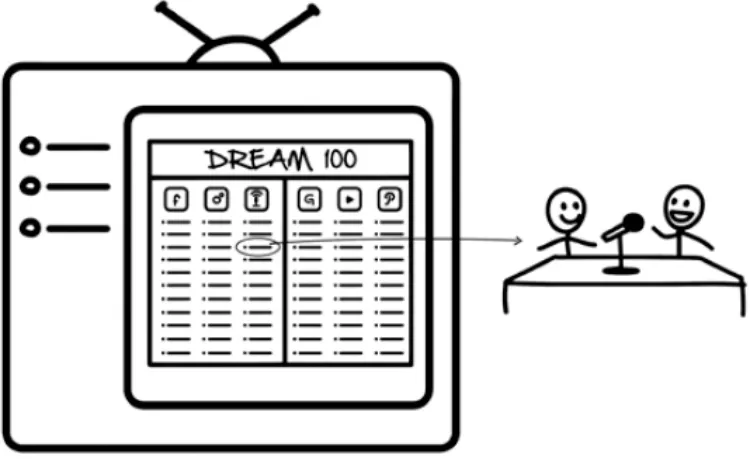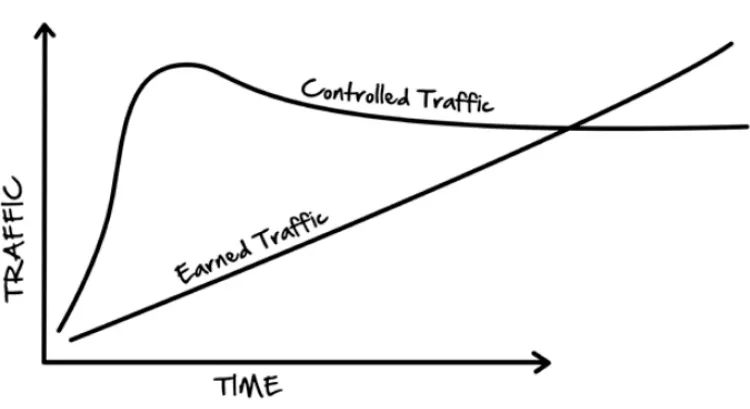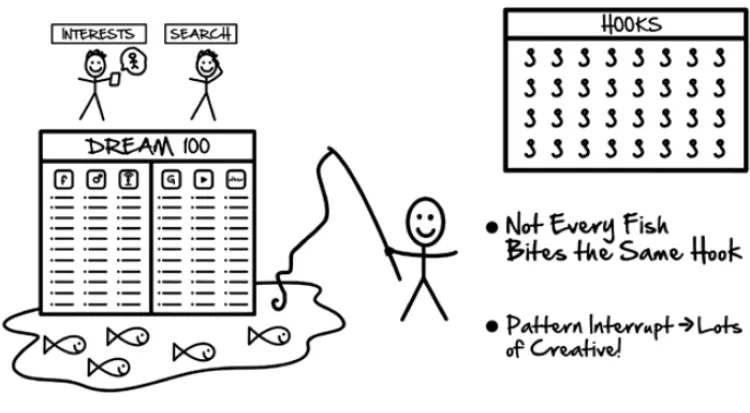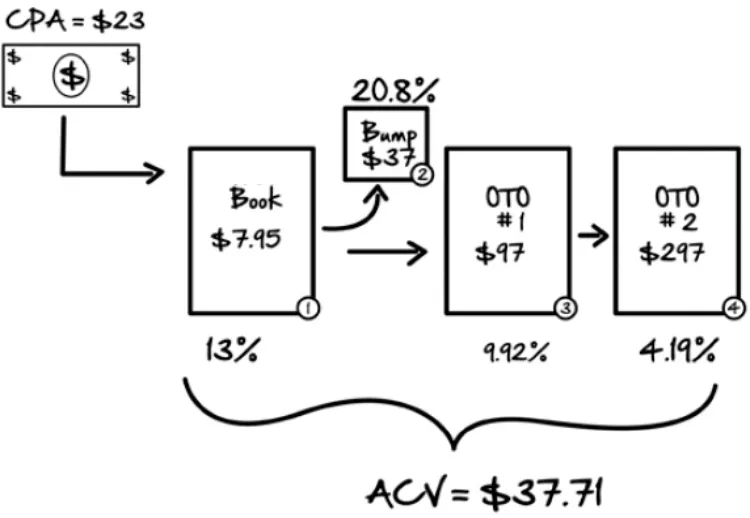Secret #4 Work Your Way in, Buy Your Way in
10 Min. Read Aug 21, 2025 #Traffic Secrets
Step #1—Dig Your Well Before You’re Thirsty
Now you have your Dream 100, and they have your dream customers. The next question you should be asking yourself is: “How do I get my message in front of their audiences?”
The most common mistake that entrepreneurs make when they start their Dream 100 is to wait to start building relationships with those people until their product is ready. If you want to build a business relationship with someone that’s worthwhile, you have to start it before you’re ready to make the deal.
This process takes a lot of work. Not only is it the foundation for getting traffic, it’s also the best market research to figure out your place in the market’s ecosystem. What problems are being unsolved by the others in your Dream 100 that you are uniquely qualified to do? What value do you have that you can provide to this market that is different?
Phase #1 (Day 1–14)
Subscribe to everything your Dream 100 are publishing. Listen to their podcast, read their blog, watch their stories on Instagram, and join their email newsletter. Comment on what they are publishing, share what you think is special. Do your homework so when you have the chance to speak to them, you’re prepared to talk about them. It also helps producing content and creating ads to attract their followers better. Since if you know the things they are saying to their followers, you can model the same language patterns in your messages. Try to do “funnel hacking”. Buy some of their products to go through their sales process to get a good idea of what they are doing and what is working in this market. Get on their customer lists to see what types of things they send to their customers.
Phase #2 (Day 15–30)
Look for ways to serve your Dream 100. It could be sending them a gift to create videos or images that they could use for their own marketing. The better and one of the easiest things to get someone’s attention and provide value to them is to talk about their product, podcast or blog socially. You may make a post on Facebook or Instagram telling people that they should try it while tagging your Dream 100 person in the post. Contact your Dream 100 (via email, direct message, etc.) and open up a dialogue. Your goal is never to pitch them anything during this time.
Red Flags
- Don’t send a templated message. Write each person a personal message or don’t send anything at all.
- Don’t tell me your story yet. You telling them your story is them serving you, and you have not built up the reciprocity yet. Serve first, or they will never have a chance to serve you later.
Green Lights
- This isn’t the first time I’ve ever seen your face. Make sure they’ve seen your face actively participating in meaningful ways in the discussions they create. During this phase you are selling you to the Dream 100, not your product.
- They’ve done their homework. They know who I am and what I care about, so when we do talk, they ask me about stuff that’s important to me.
- They don’t ask for anything now. If you ask too early, the answer will always be no.
Phase #3 (Day 31–60)
Make your Dream 100 your fan. Never ask someone to promote something for you if they haven’t experienced it. Give your Dream 100 free product and access, no strings attached, so they could use it. Your best promoters will always be your biggest fans.
Step #2—Work Your Way In (Traffic That You Earn)
 You can work your way in to your Dream 100 by appearing on their own shows.
You can work your way in to your Dream 100 by appearing on their own shows.
To launch a movie in Hollywood, the actors and actresses show up on various TV shows to promote their movie. They put out a hook to grab curiosity, tell a story to create desire, and make an offer to get people out on opening night! That’s it! They have their Dream 100, and they’re working their way in.
By using your Dream 100, you’re able to have your interviews shown to the exact target market who is likely to buy your product or service. Ask each of your Dream 100 if they would interview you on their platform. Ask them if you could spend your money to buy ads to that interview through their account and pay a $20(for example) commission on every product sold from their channel. Try to make this a huge win for them.
Not all promotions are an interview. Your Dream 100 may promote your product to email lists by sending out an email recommending purchase. Some write reviews and post it on their blogs, while others talk about it inside their Instagram stories. Let them do what is most comfortable to them. Always be grateful to them for putting you in front of their audiences.
This can and should be a consistent part of your traffic strategy. You’d better trying to do at least two per week as a starting goal. This organic, earned traffic oftentimes converts at a much higher rate than almost any form of paid traffic. It’s harder to scale, but your hottest, best buyers will typically come from an endorsement from your Dream 100. This is called “earned” traffic because you typically aren’t paying for it with money, but you are paying for it with your time.
 While controlled (paid) traffic usually produces a quick spike, the traffic typically fizzles out. Earned traffic often produces a slower amount of traffic than paid traffic at first, but usually grows over time.
While controlled (paid) traffic usually produces a quick spike, the traffic typically fizzles out. Earned traffic often produces a slower amount of traffic than paid traffic at first, but usually grows over time.
Step #3: Buy Your Way In (Traffic That You Control)
 While you’re building relationships with your Dream 100, you can still get traffic by buying it.
While you’re building relationships with your Dream 100, you can still get traffic by buying it.
Typically, if you contact all of the Dream 100 people on your list, you’ll usually get about 30 that will say yes to promote your product, and then usually only about 10 people will actually do any real promotion. Thanks to social platforms, you can still target the followings of your Dream 100 by showing paid ads directly to them.
Advantages of Paid Traffic
- Paid ads can give you immediate feedback. You can turn an ad on and within minutes have people flooding into your funnels.
- It gives you the ability to test out different hooks and see what things people in each of your Dream 100’s audience are clicking on.
- Paid ads are how you scale a company fast. Your number-one goal with every funnel is to have a “breakeven” funnel, where for each $1 you put into paid ads, you get at least $1 back.
Cost and Profit of A Funnel
Let’s say it cost us about $23(CPA, cost to acquire per customer) on average in ads to sell a book to one customer, how to design and test a funnel to make over $37 on average from every person?
The secret is to create multiple buying opportunities for our customers in our funnel, we usually break even or make a small profit on the front end, then upsell other products on the back end.
Let’s break it down into the four steps a customer goes through. Be sure to reference the below figure and read through this a few times until you grasp how “average cart value” works.

1. The Product
We make $7.95 immediately from each person who bought the book.
- Total cart value: $7.95
- We spend $23 in ads to acquire a customer, which make for a negative: -$15.05
2. Order Form Bump
On the order form, we have our first upsell for the audio book and 20.8% of our buyers add the $37 product to their order (otherwise known as a bump).
- New money collected for each buyer: $37 x 20.8% = $7.70
- Total average cart value: $7.95 + $7.70 = $15.65
- We spend $23 in ads, which make for a negative: -$7.35
3. OTO #1
After the buyer’s order, they immediately see the first of our two special upsells, which are also called one-time offers (OTOs). Our first OTO is $97 for one of our online digital courses that helps implement what they will learn in the book. This first OTO has 9.92% order conversion in a one-click upsell that allows them to add it to their order without having to re-enter their credit card information.
- New money collected for each buyer: $97 x 9.92% = $9.62
- Total average cart value: $15.65 + $9.62 = $25.27
- We spend $23 in ads, and we finally make a profit: $2.27
4. OTO #2
Then we offer a second OTO selling a course on how to get traffic into funnels for $297. This second OTO has 4.19% order conversion using a one-click upsell.
- New money collected for each buyer: $297 x 4.19% = $12.44
- Total average cart value: $25.27 + $12.44 = $37.71
- We spend $23 to get each customer, but with an average cart value of $37.71 in sales, we make a net profit for each new buyer who come into our funnel: $14.71
So when you do the math and add up all the orders, we average $37.71 in total sales for each book! We call that number the average cart value, or ACV. After the customer buy the book, we use a follow-up funnel via emails, retargeting, Messenger, and other follow-up tools to introduce them to our core product over the next 90 days.

There are two ways to scale a company fast. The first is to take on outside funding and then to use that money to either acquire other companies or pay to acquire customers. However, this way is lazy and inefficient.
The better, smarter, and more efficient way to scale a business is to create a funnel that is profitable and then to put as much money into paid ads as possible. When you have a funnel that at least breaks even, then you don’t have an advertising budget and you can spend as much money as you want without it ever costing you anything to acquire customers.